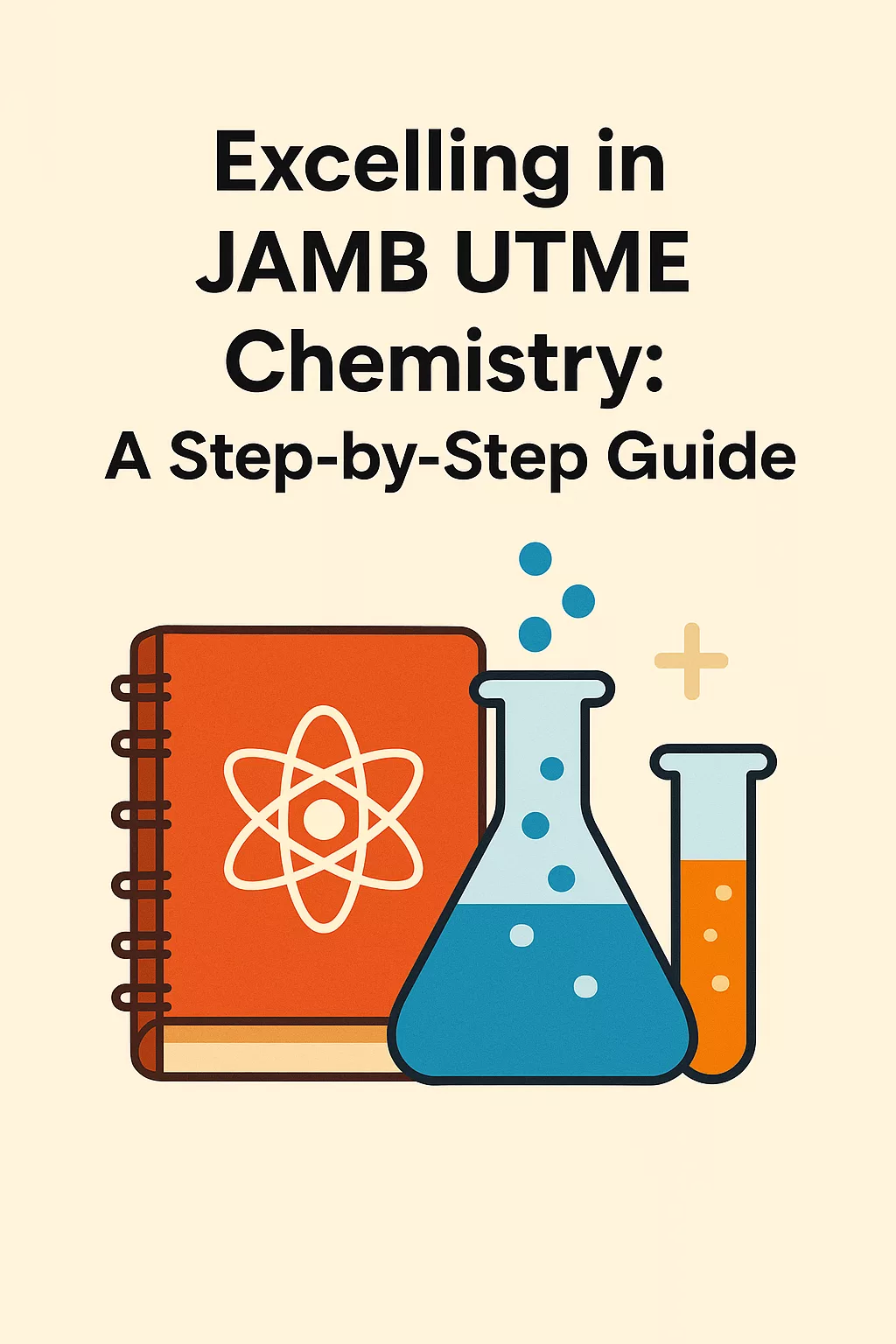1. Introduction
Chemistry can be a game‑changer in the UTME for science candidates, bridging concepts from JAMB to foundational university courses in engineering, medicine, and pure sciences. Achieving a strong Chemistry score depends on mastering theory, grasping reaction mechanisms, and honing calculation skills under timed conditions.
This comprehensive guide provides a clear roadmap: explore the core domains of physical, inorganic, and organic chemistry; learn efficient problem‑solving frameworks; and apply exam‑specific tactics to balance speed with accuracy.
Armed with structured study plans, worked examples, and targeted practice resources, you’ll approach JAMB Chemistry with confidence. Let’s dive into the molecules and equations that define your UTME success.
2. Deep Dive: Core Topics & Concept Breakdown
2.1 Physical Chemistry
- Stoichiometry & Mole Concept: Avogadro’s number, molar mass, empirical vs molecular formulas.
- Thermochemistry: Enthalpy changes, Hess’s law, calorimetry calculations.
- Chemical Kinetics: Rate laws, factors affecting reaction rates, activation energy.
- Equilibrium: Dynamic equilibrium, equilibrium constant expressions (Kc, Kp), Le Chatelier’s principle.
Worked Example
Problem: Calculate ΔH for the reaction A + B → C given two related reactions with known ΔH values.
Solution: Apply Hess’s law; reverse and scale as needed to combine equations and sum enthalpies.
2.2 Inorganic Chemistry
- Periodic Table Trends: Atomic radius, ionization energy, electronegativity across periods and groups.
- Chemical Bonding: Ionic vs covalent, VSEPR shapes, polar vs non‑polar molecules.
- Acids, Bases & Salts: pH calculations, strengths, titration curves.
- Transition Metals: Variable oxidation states, complexes, color and catalysis applications.
Quick Reference
| Trend | Direction Across Period | Direction Down Group |
|---|---|---|
| Atomic radius | Decreases | Increases |
| Ionization energy | Increases | Decreases |
2.3 Organic Chemistry
- Functional Groups: Naming and identifying alkanes, alkenes, alcohols, carboxylic acids.
- Isomerism: Structural vs stereoisomerism, cis/trans, enantiomers.
- Reaction Mechanisms: Substitution, addition, elimination, polymerization.
- Organic Synthesis: Multi-step pathways; reagents and conditions.
Mechanism Mapping
- Identify nucleophile and electrophile.
- Draw curved arrows for electron flow.
- Label intermediates and final product.
2.4 Data Interpretation & Practical Skills
- Graph Analysis: Reaction rate vs concentration, pH vs volume in titrations.
- Laboratory Techniques: Distillation, chromatography basics, safety protocols.
- Error Analysis: Random vs systematic errors; percent error calculation.
3. Exam Strategy Tips
3.1 Time Distribution
- Allocate 15 minutes each to physical, inorganic, and organic sub‑sections; reserve 15 minutes for mixed‑topic questions.
- Flag high‑calculation questions to revisit after quicker theory questions.
3.2 Problem-Solving Approach
- Interpret: Read chemical equations and data tables carefully.
- Plan: Choose formulas or principles (e.g. PV=nRT for gas questions) before solving.
- Solve: Write concise, step‑by‑step workings; use significant figures appropriately.
- Review: Check units and ensure logical consistency (mass balance, charge balance).
3.3 Elimination & Estimation
- Estimate orders of magnitude to eliminate improbable numeric choices.
- In equilibrium questions, if K > 1, products dominate; if K < 1, reactants dominate.
3.4 Diagram & Graph Questions
- Label axes clearly; note intercepts and slopes for rate laws.
- Practice sketching titration curves and reading pKa from half‑equivalence points.
3.5 Exam Day Preparedness
- Pack calculation tablets and approved periodic table.
- Stay hydrated and avoid last‑minute cramming; review flashcards during breaks.
4. Subject‑Specific Overview
4.1 Thermochemistry Applications
Link enthalpy changes to Hess’s law and bond enthalpies in organic reactions.
4.2 Periodic Trends Insights
Use trends to predict reactivity and properties of unknown elements.
4.3 Organic Mechanisms & Synthesis
Practice retrosynthesis: break complex molecules into simpler precursors.
4.4 Lab Skills Integration
Design mini‑experiments: test for cations/anions using flame tests and reagents.
5. Practice & Resources
5.1 Textbook Recommendations
- Fundamentals of Chemistry for JAMB (Success Publications)
- JAMB Chemistry Practice Questions & Answers (Knightsbridge Publishers)
5.2 Online Platforms
| Resource | Features | Access |
|---|---|---|
| Chemguide | Theory tutorials, mechanism guides | Free |
| JAMB CBT Portal | Official practice interface | Free |
| Brilliant.org | Interactive problem-solving modules | Paid |
5.3 Mobile Apps
- Organic Chemistry Essentials: Reaction flashcards.
- Chemical Calculations: Step‑by‑step problem breakdown.
5.4 Mock Exams & Review
- Three full mocks at two‑week intervals.
- Post‑exam: categorize errors by topic; adjust study focus.
6. Conclusion
Excelling in JAMB UTME Chemistry requires a balance of conceptual mastery, calculation precision, and practical exam strategies. By deepening your understanding of physical principles, inorganic trends, organic mechanisms, and laboratory techniques and reinforcing them through targeted practice you’ll develop both speed and accuracy.
Commit to a study cadence: alternate theory reviews with problem‑solving sessions, schedule regular mock exams, and analyze mistakes for continuous improvement. With the roadmap and resources provided, you’re set to elevate your Chemistry score significantly.
Start today: master one reaction mechanism or solve one calorimetry problem. Your journey to JAMB Chemistry success begins now.
